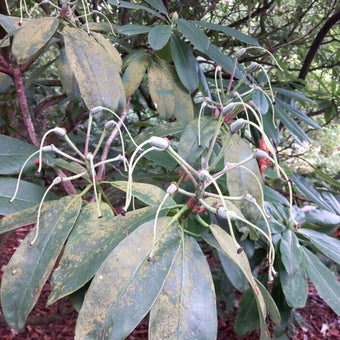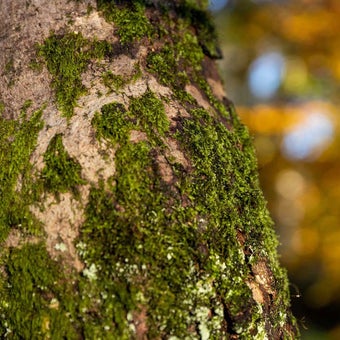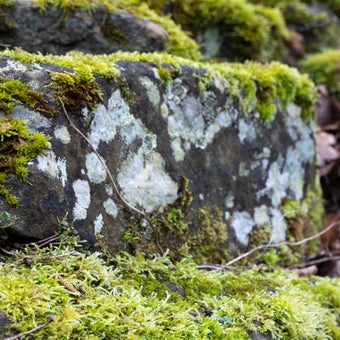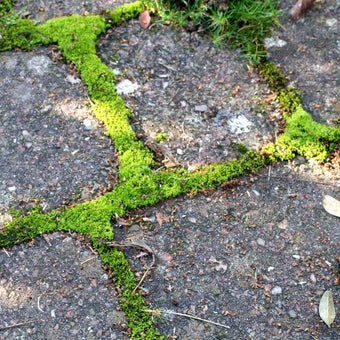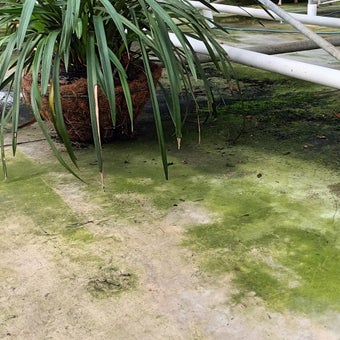
Quick facts
You’ll find most grow in moist, shady spots in the garden
On borders, they can act as useful ground cover – reducing soil erosion and surface water run-off
Algae, liverworts and mosses are an important part of garden ecosystems, providing habitat and food for many creatures
The UK has over 700 species of mosses and approximately 300 species of liverworts
There are simple, non-chemical ways to discourage algae, liverworts and mosses growing where they are not wanted
What are algae, liverworts and mosses?
Algae
Algae are simple, plant-like organisms. They can photosynthesise (harness the energy in sunlight) but don’t have true roots, stems or leaves. Algae form a thin, green layer on the surface of soil or other growing media and become powdery when dry.
Algae-like Nostoc is a type of cyanobacteria (bacteria that photosynthesises). In gardens, Nostoc species form greenish, jelly-like growths when wet, which become dark and crusty when they dry out.
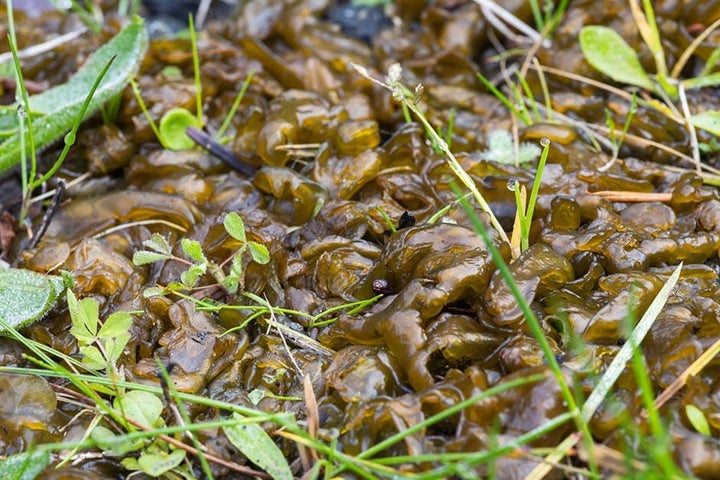
Liverworts
Liverworts are small, low-growing land plants that reproduce by spores. They lack true stems, leaves and roots, but have rhizoids (root-like growths) that anchor them to surfaces. They thrive in damp, compacted soils in shady areas. Liverworts on soil surfaces tend to produce green, flattened, plate-like growth.

Mosses
In evolutionary terms, mosses are very old, and like other early plants, they reproduce by spores rather than seed. There are many species of mosses that colonise bare soil, ranging from dense mats of flat growth, to loose tufts and rounded cushions.

See our guide to Algae, lichens, liverworts and mosses for information on where else in your garden you might find these organisms growing.
If you are interested in learning more about them, the British Phycological Society is a charity committed to the study of algae and the British Bryological Society has a very informative website on liverworts and mosses.
Do I need to get rid of algae, liverworts and mosses from borders and containers?
There is often no need to remove algae, liverworts and mosses from your borders and containers. They perform many useful functions and allowing them to grow:
- Boosts the of your garden – many species of algae, liverworts and mosses can grow in just a small area of garden.
- Provides food and habitats for a large range of garden wildlife – they offer shelter to small creatures, including beetles, spiders, springtails and woodlice, and even smaller microscopic invertebrates such as rotifers, tardigrades and nematodes. Mosses are used by garden birds as nesting material and are a food source for many moths.
- Reduces soil erosion – even a thin layer of growth on the soil surface helps to reduce valuable topsoil being washed away by heavy downpours or blown away by the wind.
- Absorbs excess water – mosses are particularly effective at absorbing water, acting like sponges to soak up rainfall, slow surface water runoff and mitigate flooding.
- Adds character and interest – algae, liverworts and mosses give gardens an atmosphere of maturity and permanence. They can form an interesting tapestry of colour and texture and are particularly useful in damp, shady areas where other plants struggle. For information on using mosses in gardens, see our page on the Magic of Moss.
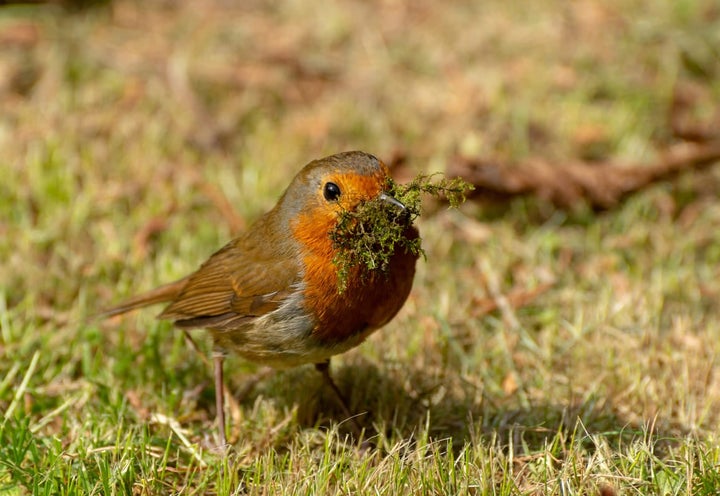

How do I control algae, liverworts and mosses on borders and containers?
In some situations, the presence of algae, liverworts and mosses might be problematic.
On seed trays and pots
When is damp, algae, liverworts and mosses can grow on the surface and slow or prevent the growth of . Emerging seedlings may struggle to break through a layer of growth above them, especially those from very fine seed. This is mainly an issue with slow-to-germinate seeds, rather than raised in spring and early summer. There are several ways to prevent algae, liverworts and mosses seed trays and pots:
- Clean trays and pots before they are used for seed sowing. Brush or rinse off old compost and debris, and clean with warm, soapy water.
- Use a clean water supply for seedlings. Where rainwater is used, ensure that gutters, fall pipes and water storage tanks are kept clean, and keep stored rainwater in covered tanks to stop debris falling in.
- Reduce watering if the compost is slow to dry out. Aim to keep the compost slightly moist but not saturated.
- Cover the compost with a thin layer of fine grit (if the seed needs to be covered). This is particularly useful if seed is slow to germinate and trays or pots are kept outside.
On borders
There is a risk that large colonies of liverworts and mosses will compete for space and light with small, delicate plants, such as alpines. There are several ways to discourage and control their growth:
- Improve drainage to prevent damp conditions, waterlogging and flooding. In extreme cases it might be necessary to install drainage, although there needs to be somewhere suitable for surplus water to be diverted to. Raising the soil level could be a good option for small areas, especially if you have a high water table. See our guide to making raised beds for more advice.
- with fibrous organic matter, such as composted , to relieve compaction and improve drainage. You don’t have to dig in organic matter, it will be taken down into the soil by worms and other invertebrates, and it will deter growth while still on the surface. Mulch annually in late winter or early spring to steadily improve soil structure. In rockeries, remove liverworts and mosses before loosening the soil surface and with grit or gravel.
- Reduce shading to make conditions less favourable for algae, liverworts and some moss species. Remove lower branches of nearby trees and shrubs, or thin out their canopies to allow more light onto the soil surface.
- Hoe off algae, liverworts and mosses and lightly rake the soil regularly to discourage regrowth.
On containers
Liverworts or mosses can form a layer that limits or prevents water soaking down into the compost. This can affect containerised plants of any size. Liverworts and mosses thrive if plants have been potted too firmly, the potting compost is old and compacted, containers are overwatered, or they are in shade. There are several ways to discourage liverworts and mosses growing on containers:
- Add a layer of mulch to the top of containers, after removing any liverworts and mosses. Top dress containers with coarse grit, gravel or fine bark chip.
- Relocate containers to a sunnier position, or into a mini rain shadow next to a wall, during the wetter, darker winter months.
- Don’t allow compost to become saturated. Ensure there are sufficient drainage holes, and they aren’t blocked.
- Repot if the compost has become old and compacted. Use a free-draining compost and mix in or horticultural grit to improve drainage if necessary. See our guide to repotting a plant for more information.
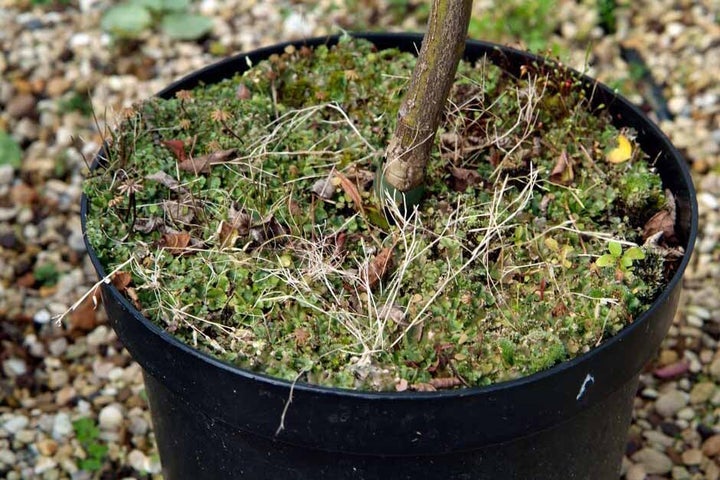
Can I use household products to kill algae, lichens and mosses?
Although often recommended online, particularly for killing mosses, do not apply household products, such as washing up liquid, salt, baking soda, vinegar, Jeyes fluid and bleach, to your soil. Gardeners mixing up their own solutions from household products regularly damage plants, soil and soil organisms, causing environmental damage.




